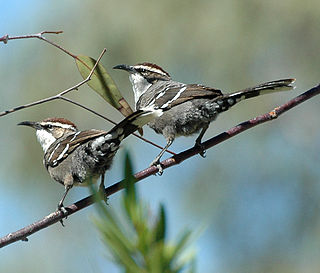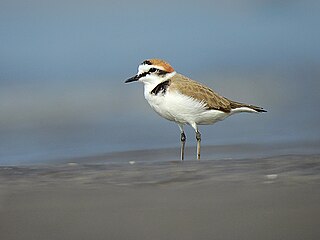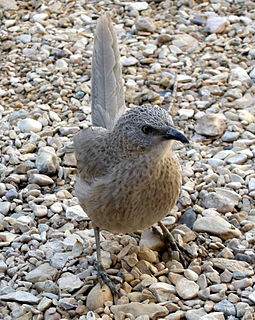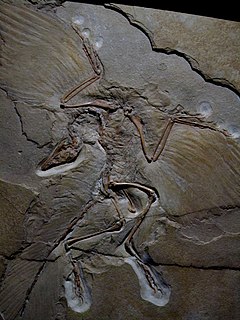
The common cuckoo is a member of the cuckoo order of birds, Cuculiformes, which includes the roadrunners, the anis and the coucals.

The killdeer is a large plover found in the Americas. It was described and given its current scientific name in 1758 by Carl Linnaeus in the 10th edition of his Systema Naturae. There are three subspecies. The killdeer's common name comes from its often-heard call. Its upperparts are mostly brown with rufous fringes, the head has patches of white and black, and there are two black breast bands. The belly and the rest of the breast are white. The nominate subspecies breeds from southeastern Alaska and southern Canada to Mexico. It is seen year-round in the southern half of its breeding range; the subspecies C. v. ternominatus is probably resident in the West Indies and C. v. peruvianus inhabits Peru and areas of the surrounding countries throughout the year. North American breeders winter from their resident range south to Central America, the West Indies, and the northernmost portions of South America.

The Pomatostomidae are small to medium-sized birds endemic to Australia-New Guinea. For many years, the Australo-Papuan babblers were classified, rather uncertainly, with the Old World babblers (Timaliidae), on the grounds of similar appearance and habits. More recent research, however, indicates that they are too basal to belong the Passerida – let alone the Sylvioidea where the Old World babblers are placed – and they are now classed as a separate family close to the Orthonychidae (logrunners). Five species in one genus are currently recognised, although the red-breasted subspecies rubeculus of the grey-crowned babbler may prove to be a separate species.

The American coot, also known as a mud hen or pouldeau, is a bird of the family Rallidae. Though commonly mistaken for ducks, American coots are only distantly related to ducks, belonging to a separate order. Unlike the webbed feet of ducks, coots have broad, lobed scales on their lower legs and toes that fold back with each step in order to facilitate walking on dry land. Coots live near water, typically inhabiting wetlands and open water bodies in North America. Groups of coots are called covers or rafts. The oldest known coot lived to be 22 years old.

The razorbill or lesser auk is a colonial seabird in the monotypic genus Alca of the family Alcidae, the auks. It is the closest living relative of the extinct great auk. Wild populations live in the subarctic waters of the Atlantic Ocean.

The European pied flycatcher is a small passerine bird in the Old World flycatcher family. One of the four species of Western Palearctic black-and-white flycatchers, it hybridizes to a limited extent with the collared flycatcher. It breeds in most of Europe and across the Western Palearctic. It is migratory, wintering mainly in tropical Africa. It usually builds its nests in holes on oak trees. This species practices polygyny, usually bigamy, with the male travelling large distances to acquire a second mate. The male will mate with the secondary female and then return to the primary female in order to help with aspects of child rearing, such as feeding.

The northern mockingbird is the only mockingbird commonly found in North America. This bird is mainly a permanent resident, but northern birds may move south during harsh weather. This species has rarely been observed in Europe. This species was first described by Carl Linnaeus in his 1758 10th edition of Systema Naturae as Turdus polyglottos. The northern mockingbird is known for its mimicking ability, as reflected by the meaning of its scientific name, "many-tongued thrush". The northern mockingbird has gray to brown upper feathers and a paler belly. Its tail and wings have white patches which are visible in flight.

The blue-headed vireo is a Neotropical migrating song bird found in North and Central America. There are currently two recognized subspecies that belong to the blue-headed vireo. It has a range that extends across Canada and the eastern coast of the United-States, Mexico and some of Central America. It prefers large temperate forests with a mix of evergreen trees and deciduous under growth.

The zebra finch is the most common estrildid finch of Central Australia and ranges over most of the continent, avoiding only the cool moist south and some areas of the tropical far north. It can also be found natively on Timor island. The bird has been introduced to Puerto Rico and Portugal.

Helpers at the nest is a term used in behavioural ecology and evolutionary biology to describe a social structure in which juveniles and sexually mature adolescents of either one or both sexes remain in association with their parents and help them raise subsequent broods or litters, instead of dispersing and beginning to reproduce themselves. This phenomenon was first studied in birds where it occurs most frequently, but it is also known in animals from many different groups including mammals and insects. It is a simple form of co-operative breeding. The effects of helpers usually amount to a net benefit, however, benefits are not uniformly distributed by all helpers nor across all species that exhibit this behaviour. There are multiple proposed explanations for the behaviour, but its variability and broad taxonomic occurrences result in simultaneously plausible theories.

The Snares penguin, also known as the Snares crested penguin and the Snares Islands penguin, is a penguin from New Zealand. The species breeds on The Snares, a group of islands off the southern coast of the South Island. This is a medium-small, yellow-crested penguin, at a size of 50–70 cm (19.5–27.5 in) and a weight of 2.5–4 kg (5.5–8.8 lb). It has dark blue-black upperparts and white underparts. It has a bright yellow eyebrow-stripe which extends over the eye to form a drooping, bushy crest. It has bare pink skin at the base of its large red-brown bill.

The blue-footed booby is a marine bird native to subtropical and tropical regions of the eastern Pacific Ocean. It is one of six species of the genus Sula – known as boobies. It is easily recognizable by its distinctive bright blue feet, which is a sexually selected trait. Males display their feet in an elaborate mating ritual by lifting them up and down while strutting before the female. The female is slightly larger than the male and can measure up to 90 cm (35 in) long with a wingspan up to 1.5 m (5 ft).

The northern jacana or northern jaçana is a wader which is a resident breeder from coastal Mexico to western Panama, and on Cuba, Jamaica and Hispaniola in the Caribbean. It sometimes breeds in Texas, United States, and has also been recorded on several occasions as a vagrant in Arizona. The jacanas are a group of wetland birds, which are identifiable by their huge feet and claws, which enable them to walk on floating vegetation in the shallow lakes that are their preferred habitat. In Jamaica, this bird is also known as the 'Jesus bird', as it appears to walk on water. Jacana is Linnæus' scientific Latin spelling of the Brazilian Portuguese jaçanã, pronounced [ʒasaˈnɐ̃], from the Tupi name of the bird. See jacana for pronunciations.

The Siberian jay is a small jay with a widespread distribution within the coniferous forests in North Eurasia. Although its habitat is being fragmented, it is a common bird with a very wide range so the International Union for Conservation of Nature has assessed its conservation status as being of "least concern".

The Kentish plover is a small cosmopolitan shorebird of the family Charadriidae that breeds on the shores of saline lakes, lagoons, and coasts, populating sand dunes, marshes, semi-arid desert, and tundra. Both male and female birds have pale plumages with a white underside, grey/brown back, dark legs and a dark bill, however additionally the male birds also exhibit very dark incomplete breast bands, and dark markings either side of their head, therefore the Kentish plover is regarded as sexually dimorphic

The Arabian babbler is a passerine bird until recently placed in the genus Turdoides. It is a communally nesting resident bird of arid scrub in the Middle East which lives together in relatively stable groups with strict orders of rank.

The southern pied babbler is a species of bird in the family Leiothrichidae, found in dry savannah of Botswana, Namibia, South Africa, and Zimbabwe.

The term seabird is used for many families of birds in several orders that spend the majority of their lives at sea. Seabirds make up some, if not all, of the families in the following orders: Procellariiformes, Sphenisciformes, Pelecaniformes, and Charadriiformes. Many seabirds remain at sea for several consecutive years at a time, without ever seeing land. Breeding is the central purpose for seabirds to visit land. The breeding period is usually extremely protracted in many seabirds and may last over a year in some of the larger albatrosses; this is in stark contrast with passerine birds. Seabirds nest in single or mixed-species colonies of varying densities, mainly on offshore islands devoid of terrestrial predators. However, seabirds exhibit many unusual breeding behaviors during all stages of the reproductive cycle that are not extensively reported outside of the primary scientific literature.

Begging in animals is when an animal solicits being given resources by another animal. This is usually a young animal soliciting food from their parents, brood hosts or other adults. However, the resource is sometimes non-food related or may be solicited by adult animals. Begging behavior is most widely studied in birds, however, mammals, amphibians, and invertebrates perform begging displays. Generally in food solicitation, begging behavior is instinctive, although in some instances it is learned.

Parental care refers to the level of investment provided by the mother and the father to ensure development and survival of their offspring. In most birds, parents invest profoundly in their offspring as a mutual effort, making a majority of them socially monogamous for the duration of the breeding season. This happens regardless of whether there is a paternal uncertainty.






















